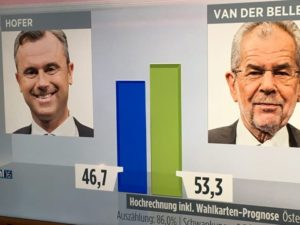
It seems that when Karl Marx spoke about historical events always happening twice, once as a tragedy, the second time as a farce,[1] he thought about Austria in regard to the farce. Indeed, the eleven month long election campaign was not free of farce. From the candidacy of a rather shrill and eccentric real estate millionaire, to the annulment of the second round of the election, the postponement of its repetition due to disintegrating election envelopes, and the Minister of Interior’s curious suggestion not to hold the (really) final round of the election on 4 December, as it would be too close to the popular St. Nicholas day celebrations (which are usually accompanied by festive drinking).
The fourth attempt to elect a president eventually did take place on 4 December, with voters choosing Alexander Van der Bellen, the former head of the liberal Green Party, over Norbert Hofer, the third Speaker of Parliament and candidate of the far-right Freedom Party. Including ballots by mail, Van der Bellen won 53.79 percent (2 472 892 votes), with Norbert Hofer getting 46.21 percent (2 124 661 votes). It is fully understandable why many people in Austria, especially members of minority communities, who had been justifiably terrified by the prospect of a far right victory, were therefore happy and relieved by the results. Their reaction corresponded with that of large parts of the liberal media and politicians throughout Europe who assumed that “Austria has stopped the neo-nationalist march in Europe” (Thomas Oppermann)[2] and who took it as “a sign that not all countries are turning their backs on rationality and progress” (The Guardian)[3].
As understandable as these reactions are, there is a danger of perceiving the apparent defeat of the far right as permission to carry on just as if nothing had happened and thereby missing the possibly last chance to prevent the far right taking control over the country in the (not too distant) future. The fact that over two million Austrians cast their ballots for a candidate who is not only one of the main ideologues of his party, but explicitly stood for an authoritarian, racist reorganisation of the society throughout the election campaign, cannot simply be brushed off with a sigh of relief that he didn’t make it in the end. Van der Bellen’s primary asset was that he was not Norbert Hofer. 42 percent of his voters stated that their main motivation was to prevent Hofer, while only 34 percent actually voted for him because they wanted him as president.[4] The fear of a far-right presidency in Austria has eventually rallied support from unlikely allies, constructing a broad front against Hofer. As painful as it is to admit, the far-right’s explanation of its narrow defeat that “this was a situation of everyone against one” (Herbert Kickl)[5] is frighteningly correct. Almost everyone in the political and public sphere expressed support for Van der Bellen: the former president, the social democratic chancellor (who even attended fundraisers), the conservative vice chancellor, the liberal ‘Neos’ party, most candidates of the first round of the election, industrialists and businessmen, most prominent cultural figures, NGOs, most of the media, etc. Yet, still the far right came historically close to winning the highest office in the country.
What explains this phenomenon? Many argue that it was the so-called ‘refugee crisis’ which allegedly pushed people towards supporting the promise of a return to an imagined ethnically-culturally homogenous past. However, there is little empirical evidence for that. For example, of the five communities in Upper Austria with the highest number of asylum seekers compared to the overall population (St. Nikola/Donau, Oberkappel, Neufelden, Gallspach, Putzleinsdorf), Van der Bellen won in three.[6] The confrontation with ‘the foreigner’ is not an indicator for people predominantly voting for the far right.
Among the major motives for a vote for Hofer was that he was perceived as “understanding the problems of people like me” (55 percent; only 28 said that about Van der Bellen), that he can “initiate important changes in society” (53 percent; 28 for Van der Bellen), and that “he is standing against the current political system” (54 percent; this didn’t even make the top 11 reasons anyone had voted for Van der Bellen).[7] Indeed, a large part of those who voted for the far right expected a worsening of their situation in the future (43 percent), while only 16 percent of Van der Bellen’s voters thought so. This is even more clear-cut in regard to what was expected for the young generation, with 59 vs. 29 percent expecting a decline in their future prospects and living standards.[8]
These primarily social and economic anxieties are not without reason. Austria has experienced a continuously sharp rise in unemployment over the past years, and currently has the highest unemployment rate since 1946.[9] In general, real wages have been stagnant for 25 years,[10] while some sectors, especially blue collar workers had income losses of up to 14 percent from 1998 to 2014 (a trend that continues).[11] It is no coincidence that the candidate to whom many ascribed the possibility of radical change (see above) won in a landslide amongst blue collar workers: 85 percent.[12] This phenomenon is also reflected geographically: while better-off areas saw a massive turnout for the green candidate, poorer, underdeveloped, and often formerly industrial areas were dominated by the far-right.[13]
This social and economic crisis yields the political crisis. The crisis of the Austrian political system already showed itself in the first round of the election, when the two candidates of the traditionally major parties, Rudolf Hundstorfer (SPÖ, former president of the Trade Union Federation and Minister of Labour) and Andreas Khol (ÖVP, the former president of parliament) lost pathetically with just over eleven percent each, making this the first presidential election in Austrian history in which none of the major parties’ candidates won. In fact, the far right won the first round in a landslide.
In 1930, Antonio Gramsci wrote: “The crisis consists precisely in the fact that the old is dying and the new cannot be born; in this interregnum a great variety of morbid phenomena appear.”[14] The tragedy of this situation is that the left seems incapable of taking up the massive anger that exists in broad layers of the society and directing it against the established capitalist parties and their racist and pro-austerity policies. This creates the space for the far right to dominate societal discourse and direct the feelings and experiences of disenfranchisement, of being neglected, and the wish for radical change towards racism and an openness to authoritarian solutions.
During the election campaign large parts of the left repeated its old misguided attempt to stop the far right by ‘proving’ that Hofer was in fact a far right extremist or a Nazi and therefore no fair-minded citizen could vote for him.[15] This moralist strategy is has been continuously failing for 25 years now. Those on the left who adopt it, have effectively ended up in the chimera of a Popular Front alliance alongside some of the most reactionary, neoliberal, capitalist forces in the country, thereby delegitimising themselves in front of large segments of the working class. Engaging in the moral crusade of proving Hofer’s affinity to Nazism (not a particularly complicated task) not only consciously ignores the underlying social and economic problems which cause the rise of the far right, but also tends to implicitly endorse the neoliberal, racist, policy and rhetoric of the established (non-Freedom Party) bourgeois forces.
Both of the major parties with whom so many on the left have found themselves in an informal alliance have largely adopted the policies and rhetoric of the far right in the past years, from the construction of a border fence and the militarisation of the border, to limitations on the number of asylum seekers accepted and culturalist discourses representing foreigners as a ‘threat’, to the cutting of social aid for non-native Austrians. Both the Social Democrats and the conservative People’s Party are in coalitions with the far right on regional and local levels, thereby not only legitimising its program and presenting them as a respectable political party, but also implementing decidedly racist policies on the practical level. Towards the end of the election campaign, even Alexander Van der Bellen found it necessary to bow to the far right’s discourse, endorsing the closure of the border, and – more subtly – refraining from showing any support by non-autochthonous-looking people in his election ads.
All this does nothing to prevent the far-right from presenting itself as the only alternative to the policies of the government and the other established parties. In fact, it eventually only serves in legitimising its discourse; especially given that large segments of the population simply don’t care anymore when some leftists try to enlighten them about the hidden history of the cornflower.[16]
While it was possible in the fourth attempt to elect a president to prevent the victory of the far right, this only seems to be a postponement. If the government survives, the next parliamentary elections will take place in 2018 and will most likely see the Freedom Party emerge as the strongest force. As long as there is no new left-wing political force which takes the grievances of those who have been experiencing a sharp decline in living standards and feeling a disenfranchisement seriously, and combines the struggle for social rights with that against racism and xenophobia, the far right will not be stoppable. If the left decides to remain in its moral comfort zone and refuses to tackle the major social and economic questions facing the working class in Austria it won’t be able to build such a force in the foreseeable future. On 4 December, the Austrian left didn’t witness a defeat of the far right, but it was granted a short breathing space. There cannot be a continuation of the old politics, or farce will quickly turn into tragedy again.
 Jan Rybak is a PhD researcher in History at the European University Institute in Florence, working on Jewish nationalism in Central-/Eastern Europe during the European crisis 1914–1921. He originates from Salzburg, Austria where he was a social worker for many years and was involved in numerous trade union, antifascist, and socialist campaigns and later studied at the University of Salzburg, SOAS London, and Tel Aviv University.
Jan Rybak is a PhD researcher in History at the European University Institute in Florence, working on Jewish nationalism in Central-/Eastern Europe during the European crisis 1914–1921. He originates from Salzburg, Austria where he was a social worker for many years and was involved in numerous trade union, antifascist, and socialist campaigns and later studied at the University of Salzburg, SOAS London, and Tel Aviv University.
[1] Karl Marx, “Der achtzehnte Brumaire des Louis Bonaparte (1852),“ in Karl Marx Friedrich Engels Werke, Vol. 8 (Berlin: Dietz, 1960), 115.
[2] http://diepresse.com/home/politik/bpwahl/5129340/Internationale-Reaktionen_Oesterreich-setzte-auf-Maessigung?gal=5129340&index=10&direct=&_vl_backlink=&popup=
[3] https://www.theguardian.com/commentisfree/2016/dec/05/defeat-austria-far-right-norbert-hofer-hope-europe
[4] http://derstandard.at/2000048756404/Warum-Van-der-Bellen-gewaehlt-wurde?ref=rec
[5] http://www.vienna.at/die-reaktionen-auf-die-wiederholung-der-bundespraesidentenwahl/5044260
[6] Upper Austria was chosen as a case study since this is one of the few regions where recent and reliable data are available. http://www.anschober.at/politik/asyl-integration/aktuelle-daten/ http://derstandard.at/2000048751925/Bundespraesidentschaftswahl-Erste-Ergebnisse
[7] http://diepresse.com/home/politik/bpwahl/5128276/Wahlgrafiken_Wer-waehlte-wen-warum
[8] http://derstandard.at/2000048756404/Warum-Van-der-Bellen-gewaehlt-wurde?ref=rec
[9] http://diepresse.com/home/wirtschaft/economist/5078413/Arbeitslosigkeit-steigt-in-Oesterreich-seit-fuenf-Jahren
[10] http://orf.at/stories/2223960/
[11] http://oesterreich.orf.at/stories/2685757/
[12] http://derstandard.at/2000048754159/Wer-wem-seine-Stimme-gegeben-hat
[13] http://derstandard.at/2000048751925/Bundespraesidentschaftswahl-Erste-Ergebnisse
[14] Antonio Gramsci, Quaderono 3: ‘Ondata di Materialismo’ e ‘Crisi di Autorità’, Quaderni del Carcere, Vol. 1 (Turin: G. Enaudi, 1975), 311.
[15] For Example: http://www.kpoe.at/innenpolitik/bundespolitik/2016/wer-den-nationalismus-zurueckdraengen-will-muss-van-der-bellen-waehlen http://linkswende.org/norbert-hofer-fpoe-ein-praesident-mit-nazi-abzeichen/
[16] In the 1920s and 30s the cornflower was a political symbol of the Nazi movement in Austria and is still worn by Freedom Party representatives on official occasions. For many antifascists this is used as prove for the FPÖ’s affinity to Nazism.

